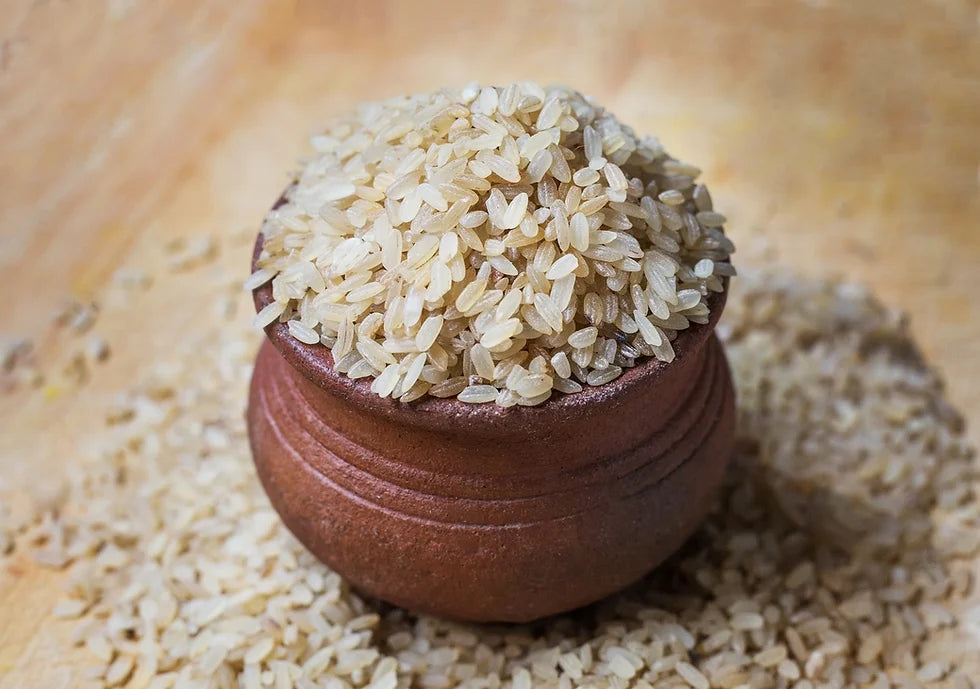#SWAHIndra
कोमल - हाडांचे आणि रक्ताचे आरोग्य
कोमल - हाडांचे आणि रक्ताचे आरोग्य
पिकअप उपलब्धता लोड करू शकलो नाही
लोह, कॅल्शियम आणि फॉस्फरसने समृद्ध असलेला हा तांदूळ हा हाडे मजबूत करतो आणि रक्त निरोगी ठेवतो.



What Makes Komal Rice Unique?
Magical Soak & Eat Rice
Komal rice, known for its unique “soak and eat” quality, makes meal preparation effortlessly convenient. Simply soaking this rice makes it soft and ready to enjoy, earning it the affectionate title of "magical rice."
Tradition Gift from Assam
Hailing from the rich agricultural land of Assam, Komal rice is a natural treasure, deeply rooted in tradition. This rice variety is a unique gift from nature, bringing centuries of cultural significance to your table.
Naturally Soft & Tender
Specially known for its soft texture when soaked, makes it ideal for quick, comforting meals. Its naturally tender grains offer a delightful eating experience that’s gentle on the stomach.
Exclusively Grown in Assam
Komal rice is grown exclusively in Assam and is not found anywhere else in the world. Its distinct features and the way it thrives in Assam’s environment make it a rare and prized rice variety.
Perfect for Assamese Festivals and Feasts
Celebrated in festivals and community feasts in Assam, Komal rice brings people together. Its versatility in creating traditional dishes makes it a go-to rice for special occasions and everyday meals.
Preserving Tradition - Sali Rice
Part of Assam's traditional Sali rice varieties, Komal rice thrives in the region's unique climate. Its photosensitive, long-duration nature makes it a cornerstone of Assam’s agricultural heritage and continues to be cherished by local farmers.
Introduction
Komal rice, also known as Chokuwa rice, is a gem from the lush fields of Assam, India, cherished for both its rich history and exceptional culinary qualities. This special variety of semi-glutinous rice has been cultivated for generations, offering a unique softness that’s unlike any other rice. Known for its low amylose content (12-17%), Komal rice becomes soft and tender just by soaking it in water, making it a perfect fit for quick, comforting meals. Loved for its delightful texture and significance in Assamese culture, Komal rice is a must-have in festive feasts and daily meals, offering both tradition and nourishment in every bite.
Nutrional values you get from our Komal Rice
A Healthy Source of Essential Nutrients
Energy
(350-370 kcal)
Carbohydrates
(75-80 g)
Protein
(6-8 g)
Fat
(0.5-1.5 g)
Dietary Fibre
(1-2 g)
Amylose Content
(12-17%)
Moisture
(12-14%)
Iron
(1-2 mg)
Calcium
(10-15 mg)
Magnesium
(20-30 mg)
Phosphorus
(80-120 mg)
Potassium
(130-150 mg)
How Komal Rice Helps You and the Planet



Nutritional Boost
Packed with essential minerals like iron, calcium, and phosphorus, Komal rice is a healthy choice for supporting bone and blood health, providing vital nutrients for a balanced lifestyle.
Promotes Sustainable Farming
Grown in the fertile lands of Assam, Komal rice thrives using traditional farming methods that maintain soil health and reduce dependency on chemicals.
Preserving Cultural Legacy
As a treasured staple in Assamese communities, Komal rice plays a central role in cultural and religious ceremonies, helping to preserve the local food traditions for future generations.
Supports Local Farmers
By cultivating Komal rice, farmers in Assam continue a centuries-old tradition, preserving their agricultural heritage while earning a livelihood from this unique crop.
FAQs
Find answers to all your key questions about Komal rice
What is Komal rice?
Chokuwa/Komal rice is a unique semi-glutinous rice variety from Assam, known for its "soak and eat" characteristic. It becomes soft when soaked in water, making it convenient for instant consumption.
What makes Komal rice unique?
Komal rice stands out with its unique “soak and eat” property, making meal preparation effortless - just soak and enjoy its naturally soft, tender grains. Grown exclusively in Assam, this rice is a precious gift from nature, deeply embedded in the region’s rich agricultural and cultural heritage. Its gentle texture makes it perfect for quick, comforting meals, while its significance in Assamese festivals and feasts highlights its role in bringing people together.
How is Komal rice nutritionally superior?
Komal rice is nutritionally rich, providing instant energy with 75-80g of carbohydrates and 350-370 kcal per 100g. Its low amylose content (12-17%) makes it easily digestible, while essential minerals like iron, calcium, magnesium, and phosphorus support bone and blood health. With dietary fibre and protein, it offers a balanced and nourishing choice for wholesome meals.
What are the health benefits of Komal rice?
Komal rice is light on the stomach and easily digestible, making it a comforting choice for all age groups. Its high carbohydrate content provides a quick and sustained source of energy, keeping you fuelled throughout the day. Packed with essential minerals like iron, calcium, and phosphorus, it supports overall well-being while offering a naturally soft and nourishing eating experience.
What is the shelf life of Komal rice?
When stored in a cool, dry place in an airtight container, Komal rice can last up to 6–12 months without losing its aroma and quality.
How do you cook Komal rice for the best results?
It does not require traditional cooking. Simply soak the rice in cold or warm water for a few minutes until soft and then eat it. It can be enjoyed with curd, milk, jaggery, or sugar.
How is Komal rice different from Basmati rice?
Unlike Basmati rice, which requires boiling or steaming, Chokuwa/Komal rice can be consumed after soaking in water for a short time. It has a low amylose content (12-17%), which gives it a soft texture.
How should Komal rice be stored?
After harvesting, it is dried and stored in traditional Assamese "Toom" or other airtight containers to maintain freshness.
Where is Komal rice grown?
It is exclusively grown in Assam, India, particularly in districts like Tinsukia, Dhemaji, Dibrugarh, Lakhimpur, Sivasagar, Jorhat, Golaghat, Nagaon, Morigaon, and Sonitpur.
Is Chokuwa/Komal rice available outside Assam?
Chokuwa/Komal rice is mainly cultivated for local consumption, but with increasing demand, some speciality stores and online platforms may offer it.
Is Chokuwa/Komal rice good for diabetics?
While it has a lower amylose content, making it more digestible, it is still a carbohydrate-rich food. Diabetics should consume it in moderation and consult a doctor for dietary advice.
Why is Chokuwa/Komal rice called "Magical Rice"?
It is metaphorically termed “Magical Rice” because of its unique ability to soften with just water soaking, making it highly convenient for quick meals.













